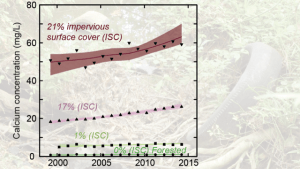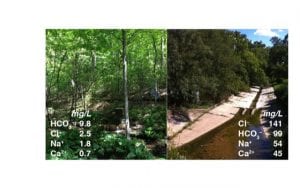Urban watersheds as weathering “hot spots”
Joel Moore, Seth Dobbis, Gregory Woodward
While nutrients, trace metals, and persistent organic molecules (e.g., PCBs and PAHs) have been studied extensively in urban streams, the processes that control the major ion chemistry (Ca, K, Mg, Na, dissolved inorganic carbon (DIC)/alkalinity, Cl, SO4, and dissolved silica) of urban streams are poorly understood. One major reason is that urban watersheds have many possible sources for major ions, and a second is that previous studies of major ion chemistry were in watersheds with mixed bedrock lithology, which meant contributions from weathering of carbonates could not be distinguished from urban sources. To date, total chemical fluxes for major ions have not yet been reported in the literature although fluxes have been calculated for subsets of these ions.
To determine the geochemistry of the urban built environment, we collected water samples from 5 small watersheds in the Maryland Piedmont that are arrayed along a forested to urban gradient with similar silicate bedrock chemistry and no significant point source discharges. The most urban watershed (~25% impervious surface area) had major ion concentrations that are 5 to 70 times higher than the forested reference watershed. Concentrations of all major ions increased along the gradient as impervious surface area increased, which has implications for bioavailability of metals and osmotic stresses on aquatic organisms. For example, the 50-fold increase in Ca concentrations resulted in much higher allowable levels of dissolved trace metals in urban streams when using the EPA hardness method to calculate the aquatic life criteria concentration.
The increase in major ion concentrations resulted in high weathering fluxes from the urban watersheds. The area-normalized weathering flux from the forested watershed was 80% lower than the global average, which is expected given the low-relief, tectonically quiescent landscape. The weathering flux for the most urban watershed was 13 times higher than the forested watershed and exceeded fluxes for mountainous watersheds in active orogenies. These results suggest that urban watersheds may be hotspots for chemical weathering.




